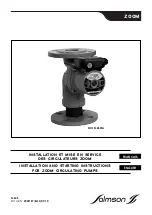
3
20.This pump is made of high-strength, corrosion-resistant materials. It will provide trouble-free service for a long time when
properly installed, maintained, and used. However, inadequate electrical power to the pump, dirt, or debris may cause the
pump to fail. Please carefully read the manual and follow the instructions regarding common pump problems and remedies.
21. Never run the pump dry, as doing so may damage the mechanical seal and void the warranty. This pump has to be
primed before starting.
PRE-INSTALLATION
APPLICATION
Pump only clean water with your Pump. To avoid clogging the pump and damaging the shaft seal, do not pump water
containing solids, foreign material, sand, silt, or abrasives.
If you are boosting the pressure from a well pump, be sure that the system check valves are tight. If the system
pressure drops when the well pump is not running, the Pump may start and cycle. Excessive or rapid cycling may
damage the motor and will void the warranty.
Do not use pipe joint compound on pump ports; use only PTFE tape to seal the threads. Pipe joint compound will
damage the controller materials.
NOTE
: The priming plug has an O-ring already installed and does not require sealing.
Tighten all the piping joints to the pump hand tight plus 1-1/2 turns (not more). Overtightening may break the pump and
will void the warranty.
Pipe and fittings to the pump should be at least nominal 1” diameter. Pipe or fittings less than 1” in diameter will reduce
performance and may damage the pump through cavitation.
Make sure that there are no air leaks or air pockets in the suction pipe. An air leak in the suction pipe may draw air in,
although no water leaks out. Air leaks and air pockets will prevent the pump from priming properly, and can substantially
reduce its performance.
The pump mount should be level, solid, as near as possible to the water source, and protected against excess moisture
and flooding.
Use the shortest possible run for piping and the smallest possible number of fittings. Long pipe runs and numerous
fittings increase friction and reduce the flow of water.
Support the weight of the piping and pump.
Do not allow the pump, pressure controller, or any system components to freeze. Freezing will damage the pump and
void the warranty.
Periodically inspect the pump, pressure controller, and system components.
NOTE:
Local code may require a pressure relief valve or pressure regulator.
CAUTION
: Risk of leaks and flooding. Do not use this pump with inlet pressure less than 10 psi (70 kPa) or greater than 50
psi (345 kPa).
WARNING:
Pressure hazard and risk of explosion. This pump can develop high pressure when
operated with the discharge shut off or obstructed. For safe operation, we recommend the
following:If not already in the plumbing system, install a pressure relief valve in the pump
discharge line capable of passing the full pump flow at 100 psi (689 kPa). If local code requires
installation of a pressure relief valve capable of handling the full pump flow at a pressure less
than100 psi (689 kPa), follow the code requirements. Run the relief valve discharge to a floor
drain or other drain that will give adequate runoff.
Figure 1 – Do Not Run the
Pump With Inlet Shut Off




























